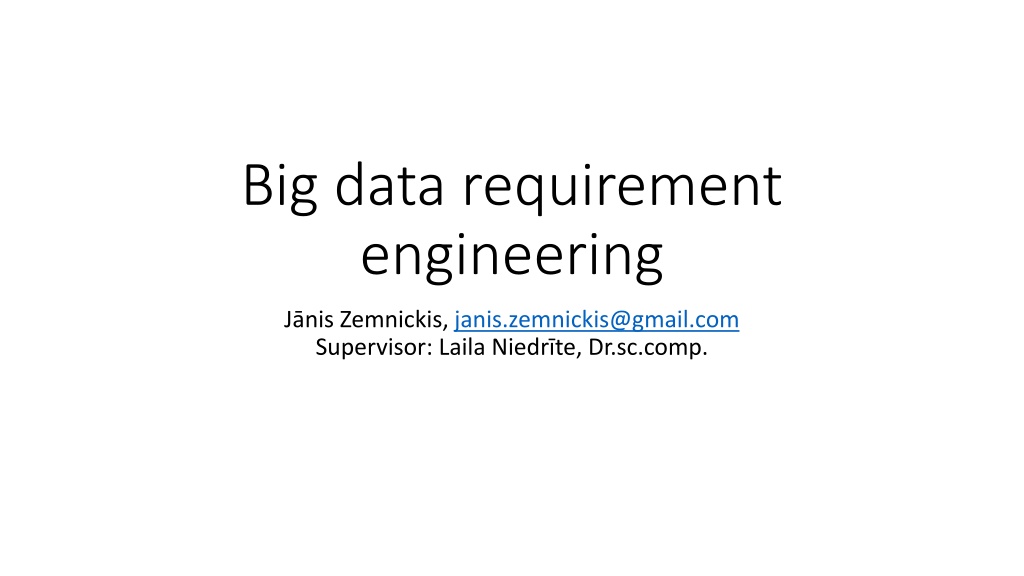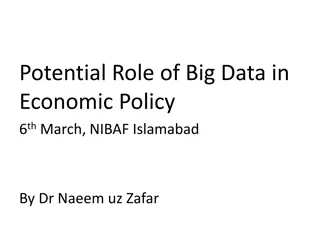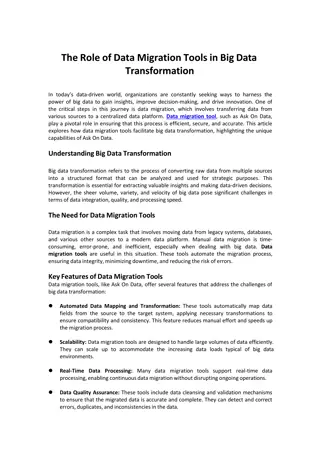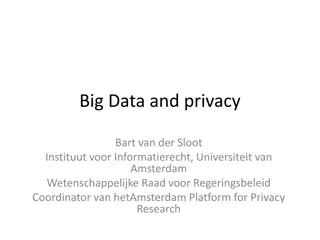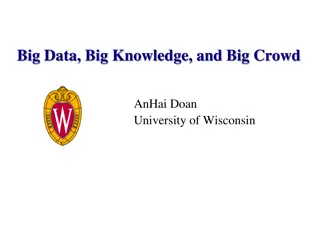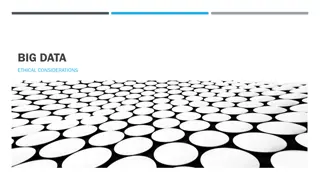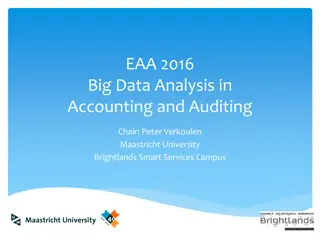Unleashing the Potential of Big Data in Requirement Engineering
Explore the transformative power of big data in requirement engineering, uncovering its impact on industries and society. Discover the challenges faced in utilizing data effectively and the solutions to bridge the gap between analytics and business objectives.
Download Presentation

Please find below an Image/Link to download the presentation.
The content on the website is provided AS IS for your information and personal use only. It may not be sold, licensed, or shared on other websites without obtaining consent from the author. Download presentation by click this link. If you encounter any issues during the download, it is possible that the publisher has removed the file from their server.
E N D
Presentation Transcript
Big data requirement engineering J nis Zemnickis, janis.zemnickis@gmail.com Supervisor: Laila Niedr te, Dr.sc.comp.
Big data Big data is a revelatory exploration of the hottest trend in technology and the dramatic impact it will have on the economy, science, and society at large. It intends to explain where we are, trace how we got here, and offer an urgently needed guide to the benefits and dangers that lie ahead. Big data refers to the authors newfound ability to crunch a vast quantity of information, analyze it instantly and draw sometimes astonishing conclusions from it. Big data will change the way we think about business, health, politics, education, and innovation in the years to come. JOHN WALKER, Saint. Big data: A revolution that will transform how we live, work, and think. 2014.
For Vs (IBM 2014) http://www.ibmbigdatahub.com/infographic/four-vs-big-data
Problems Currently, most of the manufacturing companies do not make good use of all the generated and collected data to improve production system efficiency, in turn, to increase their competiveness (Dean 2014). Implementing a business intelligence (BI) system is a costly, resource- intensive and complex undertaking (Yeoh, W., & Popovi , A., 2016). Dean, B. 2014. Data in Motion: The Next Frontier for Manufacturers. Accessed April 2014. http://www.manufacturing.net/articles/2013/08/data-in-motion-the-next-frontier-for-manufacturers YEOH, William; POPOVI , Ale . Extending the understanding of critical success factors for implementing business intelligence systems. Journal of the Association for Information Science and Technology, 2016, 67.1: 134-147.
Problems Transforming hidden insights into business value (Kelly, J.; Kaskade, J.,2013 ) Lack of business context around the data Lack of expertise to connect the dots Implicit business objectives There is a big gap between big data analytics and business (Park, G., Chung, L., Khan, L., & Park, S., 2017). KELLY, J.; KASKADE, J. CIOS & BIG DATA what your IT team wants you to know. DOI= http://blog. infochimps. com/2013/01/24/cios-big-data, 2013. PARK, Grace, et al. A Goal-Oriented Big Data Analytics Framework for Aligning with Business. In: Big Data Computing Service and Applications (BigDataService), 2017 IEEE Third International Conference on. IEEE, 2017. p. 31-40.
Problems Business intelligence do not meet project goals Not all information available Performance issues Privacy Visualization Aggregation
Data mining to discover useful information *http://accostech.com/bigdata.html
Information requirements elicitation Information requirements Information requirements User needs Organization al goals KPI Processes *http://accostech.com/bigdata.html
Input for big data requirments Business process KPI key performance indicators Organization models Information systems models
Big data requirement engineering should include (ADHAVJI, Nazim H.; MIRANSKYY, Andriy;, 2015) Creating and understanding models of the application domain Eliciting use-case scenarios and requirements from stakeholders and from other sources Developing functional and behavioural models Analysis Prioritisation Validation VAN LAMSWEERDE, Axel. Requirements engineering: From system goals to UML models to software. Chichester, UK: John Wiley & Sons, 2009. ADHAVJI, Nazim H.; MIRANSKYY, Andriy; KONTOGIANNIS, Kostas. Big picture of big data software engineering: with example research challenges. In: Proceedings of the First International Workshop on BIG Data Software Engineering. IEEE Press, 2015. p. 11-14.
Big data requirements engineering challenges Traditional software engineering may fail (Altarturi, Hamza Hussein, 2017) coordinating and organizing work between the data scientist and the software engineer(Chen, Hong-Mei; Kazman, Rick; Haziyev,2016) methodologies are usually user centric rather than data centric Different/new models maybe be requested Data models, source system specifications maybe not exist New technology new skills no specialists
Working on review paper: Requirements engineering and Big Data 243 papers was reviewed in three phases After third phase only 27 Q1.How requirement analysis applied in the context of Big data? RQ2.What empirical methods have been applied for the requirement analysis in the field of Big data? RQ3.Is it feasible to generate the information requirements in a Big data project by processing the existing data in a (semi-) automatic way?
Iterative approach YASIN, Affan, et al. Big Data Services Requirements Analysis. In: Asia Pacific Requirements Engeneering Conference. Springer, Singapore, 2017. p. 3-14.
Goal oriented approach Using big data as resource to fulfill goals Big data infrastructure specific goals requirements Output requirement model ARDAGNA, Claudio, et al. What Are My Users Looking for When Preparing a Big Data Campaign. In: Big Data (BigData Congress), 2017 IEEE International Congress on. IEEE, 2017. p. 201-208.
New big data requirement engineering method Requirement analysis phase guidelines Requirements source for big data solutions Recommendations what information should be know Recommended models How create models from requirements Data mining to discover data User don't know all data Unknown data links between entities Requirement generation (semi-) automatic way
Technologies Data mining (Carrot2, Massive Online Analysis (MOA), Angoss) Classification analysis Association rule learning Anomaly or outlier detection Clustering analysis Regression analysis NPL natural language processing (Stanford NLP) How these technologies works in big data ecosystem?
Granular computing Granular computing is a burgeoning conceptual and computing paradigm of knowledge discovery Processing different level of information granule Useful to design more effective machine learning algorithms and data mining approaches There are a few of types of granularity that are often adopted in data mining and machine learning (including variable granulation, variable transformation, variable aggregation, system granulation (aggregation)) CHEN, CL Philip; ZHANG, Chun-Yang. Data-intensive applications, challenges, techniques and technologies: A survey on Big Data. Information Sciences, 2014, 275: 314-347.
Future work Finish work on review paper about big data and requirement engineering Continue work on new methodology Methodology practical implementation Real use-case Big data enviorment Methodology implemented into framework
